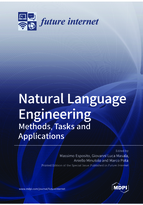Natural Language Engineering: Methods, Tasks and Applications
A special issue of Future Internet (ISSN 1999-5903). This special issue belongs to the section "Smart System Infrastructure and Applications".
Deadline for manuscript submissions: closed (31 October 2021) | Viewed by 23824
Special Issue Editors
Interests: artificial Intelligence; natural language processing; knowledge engineering; conversational systems
Special Issues, Collections and Topics in MDPI journals
Interests: artificial intelligence; machine learning; medical imaging; digital healthcare; social robots in healthcare; assistive robotics; cognitive systems
Special Issues, Collections and Topics in MDPI journals
Interests: artificial intelligence; conversational systems; natural language processing; knowledge management; modelling; reasoning
Special Issues, Collections and Topics in MDPI journals
Interests: fuzzy modeling; explainable AI; natural language processing; deep neural networks
Special Issues, Collections and Topics in MDPI journals
Special Issue Information
Dear Colleagues,
This Special Issue is intended to provide an overview of the research being carried out in the area of natural language processing to face different open issues regarding emerging approaches for single and multiple language learning, understanding and analysis, generation and grounding, interactively or autonomously from data, as well as potential or real applications of them in different domains and also in everyday devices, granting explainability and reduced memory footprints.
To this aim, this Special Issue aims to gather researchers with broad expertise in various fields—natural language processing, cognitive science and psychology, artificial intelligence and neural networks, computational modeling and neuroscience—to discuss their cutting-edge work as well as perspectives on future directions in this exciting field. Original contributions are sought covering the whole range of theoretical and practical aspects, technologies, and systems in this research area.
The topics of interest for this Special Issue include but are not limited to:
- Natural language understanding, generation and grounding;
- Multilingual and cross-lingual neural language models;
- Conversational systems, question answering and visual question answering;
- Extractive and abstractive summarization;
- Sentiment analysis, emotion detection and opinion mining;
- Document analysis, information extraction and text mining;
- Machine translation;
- Text de-identification;
- Search and information retrieval;
- Common-sense reasoning;
- Computer/human interactive learning;
- Low-resource natural language processing;
- Knowledge distillation and model compression;
- Neuroscience-inspired cognitive architectures;
- Trustworthy and explainable artificial intelligence;
- Cognitive and social robotics;
- Applications in science, engineering, medicine, healthcare, finance, business, law, education, industry, transportation, retailing, telecommunication and multimedia.
Dr. Massimo Esposito
Dr. Giovanni Luca Masala
Dr. Aniello Minutolo
Dr. Marco Pota
Guest Editors
Manuscript Submission Information
Manuscripts should be submitted online at www.mdpi.com by registering and logging in to this website. Once you are registered, click here to go to the submission form. Manuscripts can be submitted until the deadline. All submissions that pass pre-check are peer-reviewed. Accepted papers will be published continuously in the journal (as soon as accepted) and will be listed together on the special issue website. Research articles, review articles as well as short communications are invited. For planned papers, a title and short abstract (about 100 words) can be sent to the Editorial Office for announcement on this website.
Submitted manuscripts should not have been published previously, nor be under consideration for publication elsewhere (except conference proceedings papers). All manuscripts are thoroughly refereed through a single-blind peer-review process. A guide for authors and other relevant information for submission of manuscripts is available on the Instructions for Authors page. Future Internet is an international peer-reviewed open access monthly journal published by MDPI.
Please visit the Instructions for Authors page before submitting a manuscript. The Article Processing Charge (APC) for publication in this open access journal is 1600 CHF (Swiss Francs). Submitted papers should be well formatted and use good English. Authors may use MDPI's English editing service prior to publication or during author revisions.
Keywords
- natural language processing
- text analytics
- interactive and reinforcement learning
- machine/deep learning
- transfer learning
- explainability
- knowledge distillation
- cognitive systems









